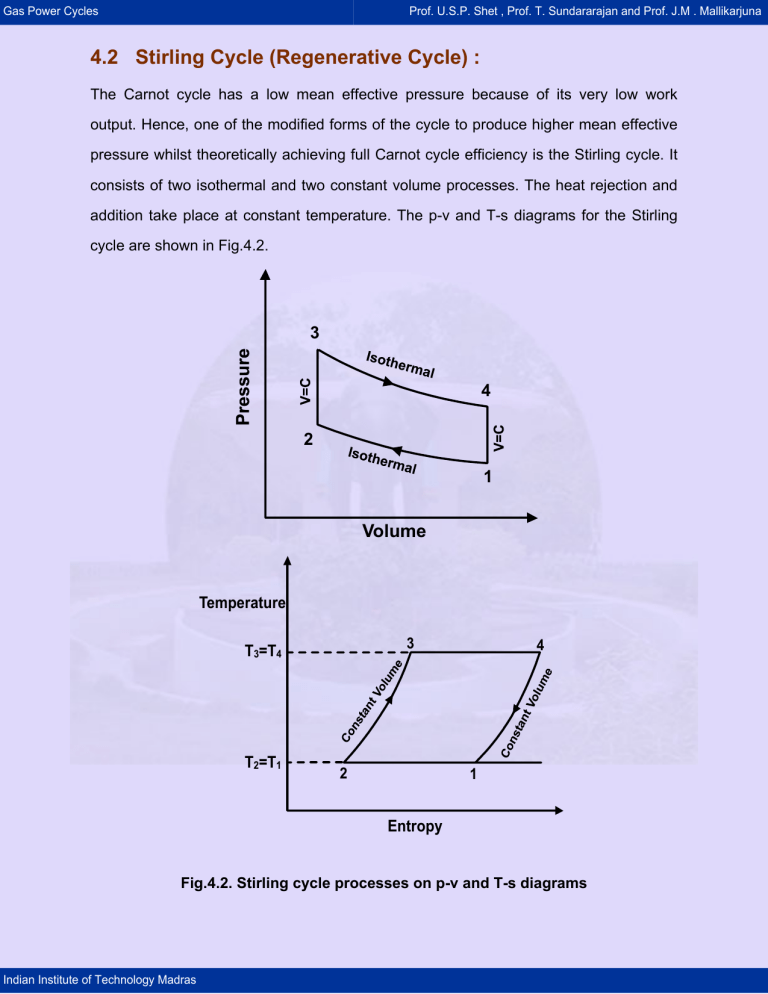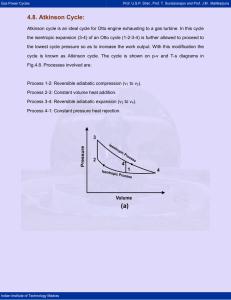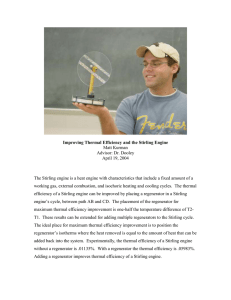
Gas Power Cycles Prof. U.S.P. Shet , Prof. T. Sundararajan and Prof. J.M . Mallikarjuna 4.2 Stirling Cycle (Regenerative Cycle) : The Carnot cycle has a low mean effective pressure because of its very low work output. Hence, one of the modified forms of the cycle to produce higher mean effective pressure whilst theoretically achieving full Carnot cycle efficiency is the Stirling cycle. It consists of two isothermal and two constant volume processes. The heat rejection and addition take place at constant temperature. The p-v and T-s diagrams for the Stirling cycle are shown in Fig.4.2. 3 4 2 1 Volume Temperature 3 T3=T4 T2=T1 2 4 1 Entropy Fig.4.2. Stirling cycle processes on p-v and T-s diagrams Indian Institute of Technology Madras Gas Power Cycles Prof. U.S.P. Shet , Prof. T. Sundararajan and Prof. J.M . Mallikarjuna Stirling Cycle Processes: (a) The air is compressed isothermally from state 1 to 2 (TL to TH). (b) The air at state-2 is passed into the regenerator from the top at a temperature T1. The air passing through the regenerator matrix gets heated from TL to TH. (c) The air at state-3 expands isothermally in the cylinder until it reaches state-4. (d) The air coming out of the engine at temperature TH (condition 4) enters into regenerator from the bottom and gets cooled while passing through the regenerator matrix at constant volume and it comes out at a temperature TL, at condition 1 and the cycle is repeated. (e) It can be shown that the heat absorbed by the air from the regenerator matrix during the process 2-3 is equal to the heat given by the air to the regenerator matrix during the process 4-1, then the exchange of heat with external source will be only during the isothermal processes. Now we can write, Net work done = W = Qs - QR Heat supplied = QS = heat supplied during the isothermal process 3-4. ⎛V ⎞ v = P3 V3 ln ⎜ 4 ⎟ ; r = 4 = CR v3 ⎝ V3 ⎠ = mRTH ln ( r ) Heat rejected = QR = Heat rejected during the isothermal compression process, 1-2. ⎛v ⎞ = P1V1 ln ⎜ 1 ⎟ ⎝ v2 ⎠ = mR TL ln ( r ) Wnet = m R ln ( r ) [ TH - TL ] Indian Institute of Technology Madras Gas Power Cycles Prof. U.S.P. Shet , Prof. T. Sundararajan and Prof. J.M . Mallikarjuna Now, ηth = m R ln ( r )( TH - TL ) TH - TL Wnet = Qs m R ln ( r ) TH TH and ηth = 1 - TL TH Thus the efficiency of Stirling cycle is equal to that of Carnot cycle efficiency when both are working with the same temperature limits. It is not possible to obtain 100% efficient regenerator and hence there will be always 10 to 20 % loss of heat in the regenerator, which decreases the cycle efficiency. Considering regenerator efficiency, the efficiency of the cycle can be written as, ηth = R ln ( r )( TH - TL ) R TH ln ( r ) + (1 - ηR ) CV ( TH - TL ) Where, ηR is the regenerator efficiency. Indian Institute of Technology Madras


